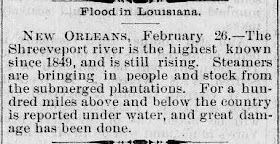 |
| Mississippi River at Natchez - 2014 |
Catahoula Parish experienced flooding at least two times during the 1880s. In its efforts to reach the Gulf of Mexico, the mighty Mississippi River carried its overflow from the north into the Lower Mississippi River Valley in 1882 and in 1884.
The Flood of 1882
In one of the early reports of flooding, the Daily Globe of St. Paul, MN posted the following on February 15, 1882:
 |
| Daily Globe - 2/15/1882 |
The Evening Critic of Washington, D.C. reported the following on March 1, 1882:
 |
| Evening Critic - 3/1/1882 |
"There is also some trouble, and prospect of more, in Louisiana. The river does not yet seem to have reached its height there, but the levees are overflowed in some places, and the backing up of water in the Red river and its tributaries is causing the overflow of a good deal of land in the western part of the state." - Vermont Phoenix of Brattleboro, VT on March 10, 1882
The Indianapolis State Sentinnel of Indianapolis, IN posted the following report from The Times-Democrat's Troy, LA on April 5, 1882:
The Flood of 1884
The River Press of Ft. Benton, MT reported on March 5, 1884:
S. B. Walters reports on conditions at Troyville, "The country is submerged. People and stock need relief." - Albuquerque Morning Journal of Albuquerque, NM on March 26, 1884
From the National Tribune in Washington, D.C. on May 22, 1884:
*This post is part two in a series of posts in which an attempt will be made to document the history of flooding in Catahoula Parish caused by the overflow of the Mighty Mississippi River. Occurrences will be presented using maps, newspaper articles, photographs and reports from the State Library of Louisiana and other collections from the sources linked below each post.
Introduction
Part One
Sources:
chroniclingamerica.loc.gov
New Yorker Magazine
The Salt Lake Herald of Salt Lake City, UT reported on March 30, 1882, "The hills of Catahoula parish are crowded with people and cattle."
The Indianapolis State Sentinnel of Indianapolis, IN posted the following report from The Times-Democrat's Troy, LA on April 5, 1882:
 |
| Indianapolis St Sentinnel - 4/5/1882 |
"The water here is three feet, ten inches above the 1874 flood. The boat rescuing cattle is supposed to have gone down in the storm of Monday on Catahoula Lake with 100 head. The hills in Catahoula Parish are crowded with people and cattle. The people dwell in pine pole huts. The water continues rising at the rate of three-quarter inches per day, and in many places has reached the eaves of the houses, compelling the people to move out.
At Lindell Place, on Black River, the high wind on Monday partly unroofed a gin house in which were twelve families, and nearly overtunred the building, greatly alarming the occupants. A man named McAdam asked to be taken from his house with his family and forty hogs, the wind threatening its destrucktion, but refused to leave without the stock. The waves raised by the winds shook the houses to the foundation.
The Times-Democrat steamer left the Black River and steamed down lanes, over fields and through quarters of several plantations, exciting the wonderment of the people who crowded the lofts of gin houses. The boat ran two miles and a half inland, the waves of the boat splashing through rooms of deserted houses."On February 23, 1987, John McPhee described the 1882 flood in the New Yorker Magazine:
"In 1882 came the most destructive flood of the nineteenth century. After breaking the levees in two hundred and eighty-four crevasses, the water spread out as much as seventy miles. In the fertile lands on the two sides of Old River [Louisiana], plantations were deeply submerged, and livestock survived in flatboats."
The Flood of 1884
The River Press of Ft. Benton, MT reported on March 5, 1884:
"For hundreds of miles above and below the country [Shreveport area] is reported under water, and great damage has been done."
 |
| River Press - 3/5/1884 |
S. B. Walters reports on conditions at Troyville, "The country is submerged. People and stock need relief." - Albuquerque Morning Journal of Albuquerque, NM on March 26, 1884
 |
| Albuquerque Morning Journal - 3/26/1884 |
From the National Tribune in Washington, D.C. on May 22, 1884:
Appeals for relief continue to pour in upon the Secretary of War and upon General J. Lloyd King from residents of the flooded districts of North Louisiana. Almost the entire congressional district represented by General King, an area larger than the entire state of New Jersey, is under water, and the condition of affairs there is most distressing.
A letter from Mrs. H. E. Bowman, postmistress at Wild Wood, Catahoula parish, says that the nearest dry land is thirty miles distant.
 |
| National Tribune Washington DC - 5/22/1884 |
*This post is part two in a series of posts in which an attempt will be made to document the history of flooding in Catahoula Parish caused by the overflow of the Mighty Mississippi River. Occurrences will be presented using maps, newspaper articles, photographs and reports from the State Library of Louisiana and other collections from the sources linked below each post.
Introduction
Part One
Sources:
chroniclingamerica.loc.gov
New Yorker Magazine



No comments:
Post a Comment